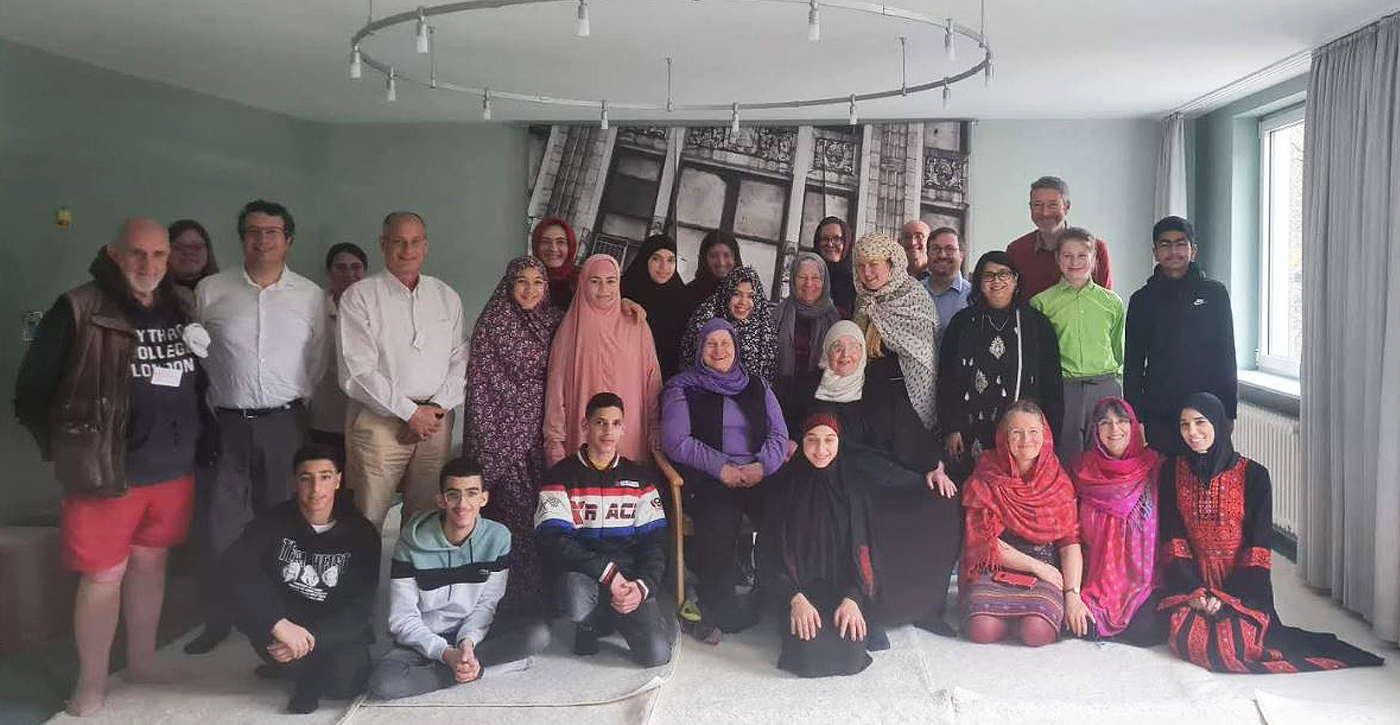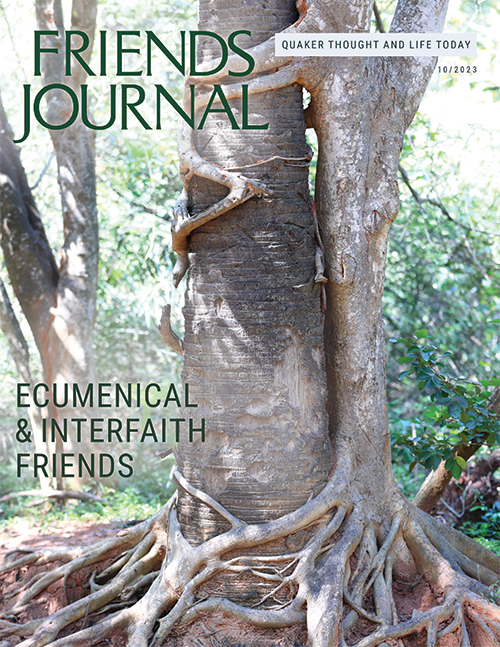50 Years of the Jewish-Christian-Muslim Interfaith Conference
Do you work gladly with other religious groups in the pursuit of common goals? While remaining faithful to Quaker insights, try to enter imaginatively into the life and witness of other communities of faith, creating together the bonds of friendship.—Britain Yearly Meeting Advices and Queries
Our group fans out around the cemetery, crunching through the carpet of gold, milk chocolate, and topaz leaves. Large raindrops are cracking and rustling here and there. Gravestones keep watch: still and silent sentries, some upright and alert, others beginning to tire and lean a little.
In February of this year, my wife, son, and I were privileged to attend the fiftieth Jewish-Christian-Muslim (JCM) Conference, in Vallendar, Germany. It was our son’s first time there. He would normally have spent the half-term holiday with his grandparents and grumbled when we insisted that he should attend at least once in order to have the experience, then irritably relented.
JCM was the brainchild of a brilliant group of friends: scholar, writer, and media figure Rabbi Lionel Blue and Winfried Mächler, then-pastor of the Dietrich Bonhoeffer Church in London, who together began to consider the question of what could the church offer to Jewish people now rather than endlessly returning to a sense of guilt?
It was a lively question that they continued to work on after Mächler had moved to a new post in Berlin. Their conversation was then joined by Salah Eid, a Muslim scholar working with university students in Berlin, and Annaliese Debray, a Roman Catholic theologian and director of the Hedwig Dransfeld Haus in Bendorf, Germany, where JCM was originally based. Owing to financial and logistical pressures, the conference later migrated to different locations around Germany, before finding its current home at another Catholic retreat center in Vallendar, a mere ten minutes by car from its birthplace in Bendorf.
The conference was conceived as a real-time exercise in living, loving, and learning together for members of the three Abrahamic faiths. There are many working parts that contribute to the magic of the whole, including three keynote lectures—one delivered by a member of each of the faiths—which address the conference theme. Some recent themes have included: between two worlds: living with the difficulties presented by different languages, cultures, and social expectations; interfaith dialogue in situations of conflict; power and authority in the religious traditions; and the uses and abuses of religious language.
These lectures are followed by plenaries and forums to pursue matters that arise. There is also a range of other activities that attendees are encouraged to engage with. Amongst these, seminars this year included Torah–Qur’an study and an exploration of healing Scripture stories. Discussion groups, which all participants are required to attend, are designed to include a range of backgrounds. Mine included a secular Israeli rabbi; a German Liberal rabbi from North London; and a Palestinian Muslim actor, teacher, and activist. These discussion groups are vital to the effective running of the conference. Anything can be aired in them: comments and questions developing from the lectures, seminars, or any other activity; also, general questions about the religious practices or cultures of different faith groups. Conversations and contributions are confidential, with nothing off the table, which inevitably leads to some deep and searching—and at times robust and challenging—conversations.
Left to right: The fiftieth anniversary JCM poster. Image courtesy of JCM. Friday prayers in the JCM mosque. Photo courtesy of Monika Doering. Three younger participants of JCM. Photo courtesy of Monika Doering.
As the week proceeds, old connections are rekindled and new friendships forged as we begin to emotionally, imaginatively, spiritually enter into each other’s experiences of the Divine. Tuesday evening sees Taizé meditation; Thursday evening Muslim Dhikr, laying the ground for Friday midday Muslim prayers. On Friday evening, we share the Shabbat meal and service together, leading onto Havdalah on Saturday evening, and culminating with Christian worship on Sunday morning. There is also a mid-week trip, sometimes further afield (the last time that I attended, the visit was to Bonn) and sometimes closer. This year being the conference’s fiftieth anniversary, we made a pilgrimage to JCM’s original home in Bendorf.
We walked from the town center up towards the retreat center, which has now been converted into a hotel. Some longtime attendees led us around the complex of buildings, reminiscing about different memories. We then made our way up the hill; the rain and our feet worked the clay-rich soil in places to a slick sheen. We picked our way gingerly upwards, eventually finding ourselves in a short, artificial gorge leading to the gate of the cemetery, which is well-preserved but not in current use. A chain link fence stretched around the perimeter. Stefan, a former priest and now a married Catholic with three children, full-time charity worker, and part of the JCM team, had been given a key for the gate, but it didn’t fit the lock. Someone had apparently mixed them up, but he was sanguine and made his way up the bank to the left of the gate to a loose section of the fence. He folded the wire back to create an entry, and one by one, we crouched and stepped through. I waited my turn and stooped through, turning over how appropriate it felt to be gaining access this way.
Most of the conference participants were there, including ten Palestinian Muslim teenagers, an Israeli art teacher who was about to begin training as a Reform rabbi, an Australian Liberal rabbi called Mark, and a Swiss-German Quaker physiotherapist.
We wandered a little amongst the stone witnesses: some inscribed in Hebrew, others in German, some in both languages. Two names that caught my eye were Lina Seligmann (1864–1931) and Simon Abraham, born 1885, whose date of death is eroded from his gravestone.
Another stone that stood out carried a carving of two hands held downwards in a traditional blessing, splayed out in the manner of Mr. Spock in Star Trek. Mark explained that this was an old gesture of blessing used by Jewish priests. The hands, with the second and third fingers spread in a V-shape, have the look of rays beaming down, which Leonard Nimoy then used when improvising his role. The carving had a fresh, vulnerable quality; the outline of the fingers looked a little wobbly, almost as if they had been sketched by a pencil rather than chipped out of stone.
Left to right: An Israeli professor and a German rabbi amongst the gravestones. A Jewish gravestone inscribed with Hebrew and German. Jewish gravestone with distinctive image of blessing hands. Photos courtesy of Monika Doering.
We speculated on the rise and fall of a small but strong Jewish community, who clearly spent time and money honoring their dead. As we moved amongst the slumbering stones, I remembered the sermons preached at the earlier JCM Shabbat service, which began with the image of a memorial stone laid in Vallendar to remember the town’s four Jewish citizens: two elderly couples who were deported during the Holocaust.
As the raindrops pattered into the leaves strewn around us, Rabbi Mark, blessed with a beautiful tenor voice, sang the Kaddish. We picked our way back down the hill, had coffee in a German Turkish café in the town, and went on a guided tour of the local church. Our friendly guide talked about the historical evolution of the church as the region changed sympathies from Catholicism to Lutheranism. We heard about war damage, and how the two different Christian communities divided the worship space between them.
Then we were taken into one of the old chapels. As we admired the mural behind the altar, the scene was explained: it depicts the burial of Jesus’s mother Mary by the Apostles. Our guide indicated one figure below those carrying Mary’s remains, who is reaching up and touching her. The distinctive hat worn by the figure is in fact a hat that Jews were required to wear in the Middle Ages. The message is that he is trying to topple Mary from the hands of the Apostles in an attempt to disrespect the mother of Jesus Christ. It was a jarring moment. Such a detail could be so easily misunderstood or overlooked but now suddenly stood out of the mass of imagery: unavoidable and thorny.
The Israeli art teacher and I later talked, and she returned to this image: “How can you worship in a space with such a hateful image in it?” This pulled me up short. There were of course several easy responses that I could have offered. As a Quaker, although I do also attend church services, the mainstay of my worship is in meetinghouses that do not feature any visual imagery, still less anything of this nature. Obviously, all religions are on a journey, and the prejudices that came easily to some adherents of religions in the past would not be acceptable now. The Christian service that is organized as part of JCM would be conducted in a beautiful, open space that only has one or two relatively unobtrusive Christian images.
Yet her question stood, and I found myself feeling grateful that we weren’t attending a service in that church building. I told her that I’m ashamed of that antisemitism; that although I consider myself to be a Christian Quaker and have no truck with Christian antisemitism, I can’t deny that it has existed and continues to exist. There is no easy answer that will solve it; I can only hope to return to these issues and to keep chipping away at them. That image, like a cheap comic-book slur, stood in my memory around the gaudy, red smear of the hat. It feels important not to forget it, to continue confronting it. This conference, after all, is one more step.
With surprising speed, our time came to an end: our bags were packed and we took leave. That night, after the various car, train, and plane journeys are over but still ringing in my ears, I went into our son’s room to wish him a good night and found him sitting on the edge of the bed, tearful.
“What’s the matter?”
“I didn’t want this week to end.”
I have a hopeful sense that he may be persuaded to return next year.










Comments on Friendsjournal.org may be used in the Forum of the print magazine and may be edited for length and clarity.